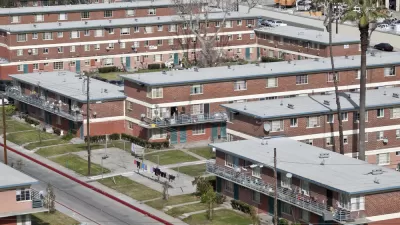Brookings provides a manifesto, of sorts, to suggest an entirely new path forward on infrastructure policy.

Adie Tomer, Joseph W. Kane, and Lara Fishbane write on the continued sluggishness of change on infrastructure policy at the federal level, three years after a presidential election in which both parties made the issue a central point in campaign platforms.
Now, just one year away from another presidential election, the federal government is no closer to wholesale infrastructure reform than it was in 2016. What went so wrong?
The trio of writers suggests that politics was not the problem. The reason was a failure to commit to a process of legal reform.
To enact genuine reform—legislation that completely reshapes the government’s approach to infrastructure programming, funding, and regulation—federal leaders must be willing to revisit the fundamental goals the country’s infrastructure systems intend to achieve and honestly assess whether current policies share those objectives.
The current system is built on obsolete foundations—connecting across straight lines, telephone cable service, and sewage dumping—according to the article. The challenges of today and the future include "the most extreme income and wealth inequality since the Gilded Age, economic divergence caused by digitalization and global trade, the existential pressures of climate change," and will require different policies.
Here is how the article summarizes the key recommendation about how Washington can accomplish progress on infrastructure policy:
To maximize value from existing infrastructure systems and strategically prioritize future improvements, the federal government must adopt a new set of economic, social, and environmental goals. Our federal leaders and their state, local, and civic collaborators must be willing to rebuild our policies from the ground up, designing new approaches where it makes sense and keeping those legacy programs that still respond to today’s challenges.

Alabama: Trump Terminates Settlements for Black Communities Harmed By Raw Sewage
Trump deemed the landmark civil rights agreement “illegal DEI and environmental justice policy.”

Planetizen Federal Action Tracker
A weekly monitor of how Trump’s orders and actions are impacting planners and planning in America.

The 120 Year Old Tiny Home Villages That Sheltered San Francisco’s Earthquake Refugees
More than a century ago, San Francisco mobilized to house thousands of residents displaced by the 1906 earthquake. Could their strategy offer a model for the present?

Ken Jennings Launches Transit Web Series
The Jeopardy champ wants you to ride public transit.

BLM To Rescind Public Lands Rule
The change will downgrade conservation, once again putting federal land at risk for mining and other extractive uses.

Indy Neighborhood Group Builds Temporary Multi-Use Path
Community members, aided in part by funding from the city, repurposed a vehicle lane to create a protected bike and pedestrian path for the summer season.
Urban Design for Planners 1: Software Tools
This six-course series explores essential urban design concepts using open source software and equips planners with the tools they need to participate fully in the urban design process.
Planning for Universal Design
Learn the tools for implementing Universal Design in planning regulations.
Clanton & Associates, Inc.
Jessamine County Fiscal Court
Institute for Housing and Urban Development Studies (IHS)
City of Grandview
Harvard GSD Executive Education
Toledo-Lucas County Plan Commissions
Salt Lake City
NYU Wagner Graduate School of Public Service





























